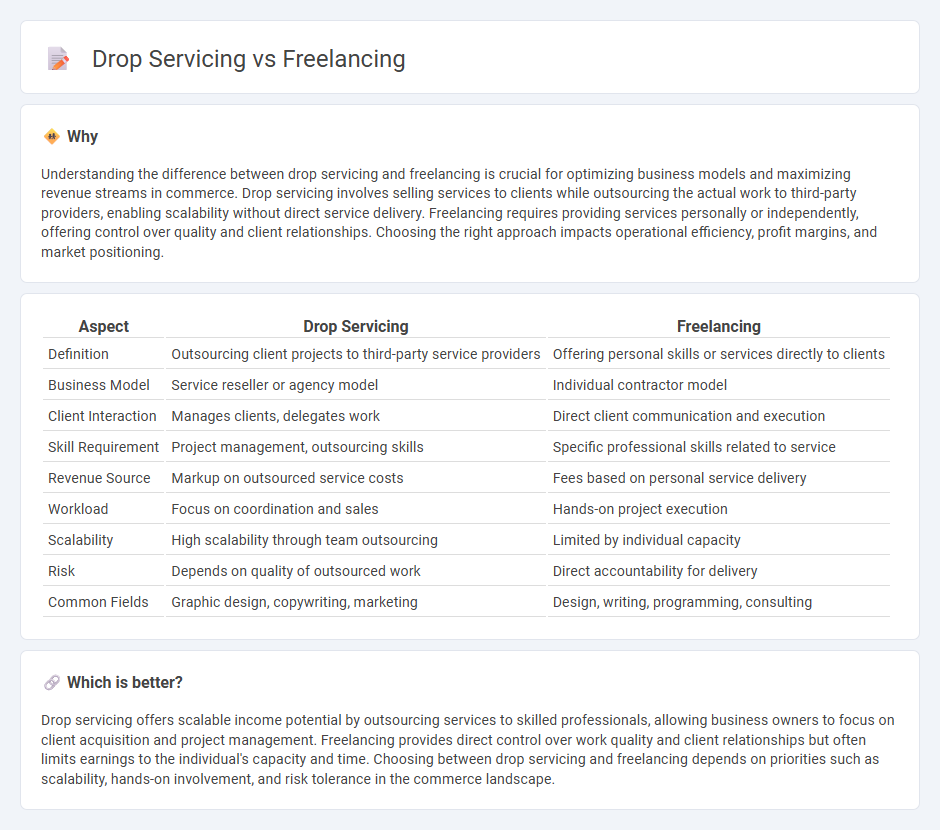
Drop servicing involves selling services performed by third-party providers, allowing business owners to manage client relationships without directly executing the work. Freelancing requires individuals to offer their own skills and complete projects personally for clients. Explore the advantages and challenges of drop servicing and freelancing to determine the best path for your commerce goals.
Why it is important
Understanding the difference between drop servicing and freelancing is crucial for optimizing business models and maximizing revenue streams in commerce. Drop servicing involves selling services to clients while outsourcing the actual work to third-party providers, enabling scalability without direct service delivery. Freelancing requires providing services personally or independently, offering control over quality and client relationships. Choosing the right approach impacts operational efficiency, profit margins, and market positioning.
Comparison Table
| Aspect | Drop Servicing | Freelancing |
|---|---|---|
| Definition | Outsourcing client projects to third-party service providers | Offering personal skills or services directly to clients |
| Business Model | Service reseller or agency model | Individual contractor model |
| Client Interaction | Manages clients, delegates work | Direct client communication and execution |
| Skill Requirement | Project management, outsourcing skills | Specific professional skills related to service |
| Revenue Source | Markup on outsourced service costs | Fees based on personal service delivery |
| Workload | Focus on coordination and sales | Hands-on project execution |
| Scalability | High scalability through team outsourcing | Limited by individual capacity |
| Risk | Depends on quality of outsourced work | Direct accountability for delivery |
| Common Fields | Graphic design, copywriting, marketing | Design, writing, programming, consulting |
Which is better?
Drop servicing offers scalable income potential by outsourcing services to skilled professionals, allowing business owners to focus on client acquisition and project management. Freelancing provides direct control over work quality and client relationships but often limits earnings to the individual's capacity and time. Choosing between drop servicing and freelancing depends on priorities such as scalability, hands-on involvement, and risk tolerance in the commerce landscape.
Connection
Drop servicing and freelancing intersect through their shared reliance on individual service providers delivering skills-based work directly to clients. Drop servicing acts as an intermediary model where entrepreneurs outsource freelancing tasks such as graphic design or content writing, creating a scalable commerce system without performing the services themselves. This hybrid approach leverages freelancing platforms and digital marketing to streamline service delivery and maximize profit margins in the online commercial landscape.
Key Terms
Service Delivery Model
Freelancing involves individuals directly offering specialized skills and services to clients, managing every aspect from communication to execution. Drop servicing operates as a service arbitrage model where the drop servicer markets services and outsources the actual delivery to third-party freelancers or agencies, focusing on client acquisition and project management. Explore deeper insights to understand which service delivery model suits your business goals best.
Client Acquisition
Freelancing involves directly offering specialized services such as graphic design or content writing to clients, requiring active client outreach and relationship management to build a steady pipeline. Drop servicing focuses on selling services by acting as a middleman, outsourcing tasks to freelancers while managing client acquisition through marketing and sales strategies. Explore detailed strategies on client acquisition for both models to maximize your freelancing or drop servicing success.
Revenue Structure
Freelancing generates revenue through direct client payments for completed tasks or projects, often relying on individual skills and time investment. Drop servicing earns revenue by selling services to clients and outsourcing the actual work to third-party providers, creating a margin between the client's payment and the outsourced cost. Explore the key differences and benefits of each revenue structure to determine which model suits your business goals best.
Source and External Links
What Is Freelancing? Basics and Popular Jobs in 2025 - Freelancing is self-employed work done for clients without full-time commitment, involving steps like picking a niche, building a portfolio, setting rates, and managing taxes independently.
Freelancing 101: What is Freelancing? - Freelancing is a flexible form of self-employment allowing professionals to work for various clients, control their schedules, and work from anywhere via the internet using their unique skill sets.
25 best freelance websites to find work in 2025 - Freelancing offers freedom to choose clients and projects, flexible hours, with beginners encouraged to build their skills and client base using freelance platforms like Fiverr and Toptal.
 dowidth.com
dowidth.com